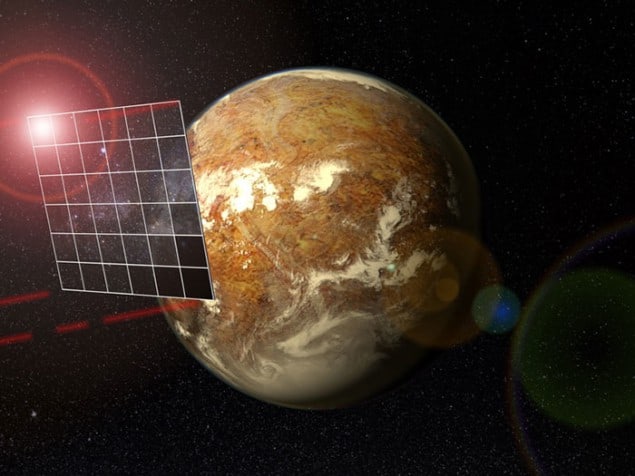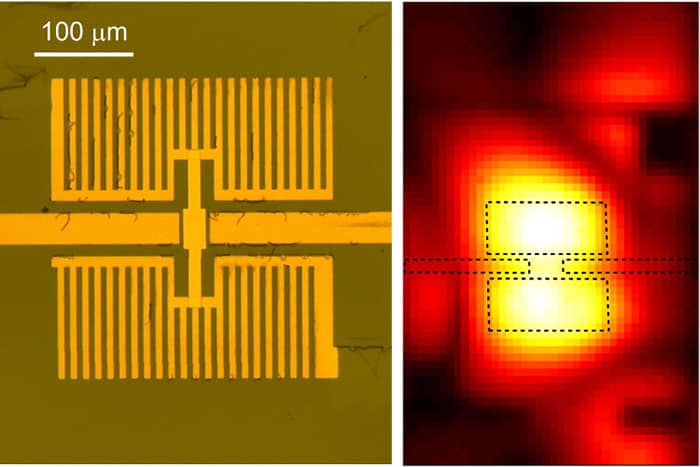Flash Physics is our daily pick of the latest need-to-know developments from the global physics community selected by Physics World‘s team of editors and reporters

Applying the brakes at 20% the speed of light
A possible braking system has been devised for the tiny, ultrafast spacecraft being developed as part of Breakthrough Starshot. In 2015, billionaire Yuri Milner began funding space-exploration research. The Starshot project is one of his three Breakthrough Initiatives and aims to develop and demonstrate ultralight, miniature spacecraft and send them to the closest star system, Alpha Centauri. The proposed “nanocraft”, which are currently in the theoretical stage, will consist of extremely small electronic cargo attached to a large, very thin sail. Once launched into space, a powerful laser on Earth will be fired at the sail causing it to accelerate to 20% the speed of light. Although this would mean the unmanned spacecraft could travel the 40 trillion km to Alpha Centauri in only 20 years, one of the many questions is how to stop the nanocraft from shooting past its destination. René Heller of the Max Planck Institute for Solar System Research in Germany and his colleague Michael Hippke have calculated a possible solution. In their simulation, the nanocraft weighs less than 100 g and the sail is a massive 100,000 m2. They propose redeploying the sail as is approaches Alpha Centauri, which would allow incoming radiation from the star system to slow the small probe. The stars’ gravitational fields would also attract the spacecraft and deflect it in a swing-by manoeuvre often used by space probes in the solar system. Although this feat requires precise positioning and approach speeds, it could allow the small, unmanned probe to reroute to the nearby red-dwarf star Proxima Centauri and the Earth-like planet Proxima Centauri b. Heller and Hippke present their findings in The Astrophysical Journal Letters.
Graphene-based thermometer combines pyroelectricy with bolometry

A new type of infrared thermometer that is based on graphene has been unveiled by an international team of researchers working under the European Union’s Graphene Flagship research initiative. The highly sensitive device operates at room temperature (unlike some other infrared detectors) and combines two infrared detection techniques – pyroelectricity and bolometry. Pyroelectric materials experience a change in electrical polarization with tiny changes in temperature, whereas bolometric materials experience a change in electrical resistance. The team fabricated an electrical circuit that is sensitive to changes in both polarization and resistance and used graphene – a sheet of carbon just one atom thick – to amplify the temperature-dependent signal. According to the researchers, the high electrical conductivity of graphene meant that the device could be built without the need for external transistors – which they say reduced both losses and noise in the system. The device can measure changes in temperature as small as 15 μK and is described in Nature Communications.
New cooling method could boost atomic-clock accuracy
A new way of improving the accuracy of atomic clocks by further cooling trapped ions has been developed by Jwo-Sy Chen and colleagues at NIST in Boulder, Colorado. Ions in the world’s best atomic clocks are cooled to very low temperatures, which allows the clocks to have accuracies of 10–18. However, when laser light is shone on these ions to measure the clock frequency, the ions will heat up – and this makes it very difficult to cool the ions further to boost clock performance. Now, Chen and colleagues have worked out a way to use the well-established “resolved sideband” cooling techniques to solve this problem. By creating a new ion trap, they have been able to reduce the laser heating of the trapped ions by a factor of 100. According to their measurements and computer simulations, their technique should make it possible to create a clock that is accurate to within 10–19. The new cooling technique is described in Physical Review Letters.
- You can find all our daily Flash Physics posts in the website’s news section, as well as on Twitter and Facebook using #FlashPhysics. Tune in to physicsworld.com later today to read today’s extensive news story on a new heat transistor.



